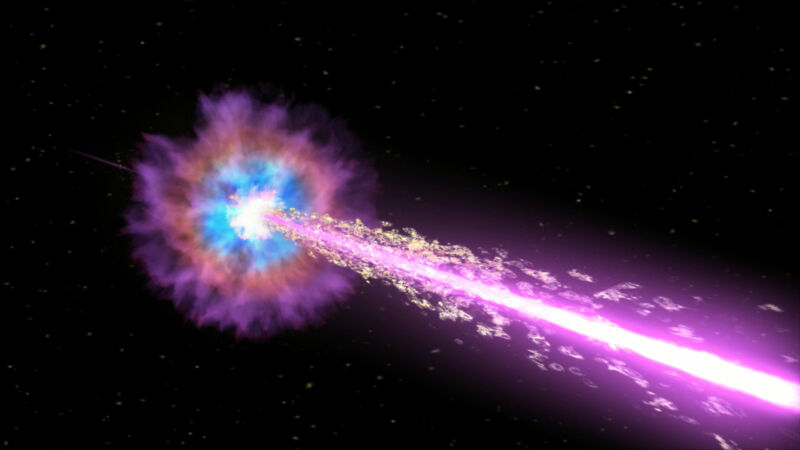Supernovae are some of the most energetic events in the Universe. And a subset of those involves gamma-ray bursts, where a lot of the energy released comes from extremely high-energy photons. We think we know why that happens in general terms—the black hole left behind the explosion expels jets of material at nearly the speed of light. But the details of how and where these jets produce photons are not at all close to being fully worked out.
Unfortunately, these events happen very quickly and very far away, so it's not easy to get detailed observations of them. However, a recent gamma-ray burst that's been called the BOAT (brightest of all time) may be providing us with new information on the events within a few days of a supernova's explosion. A new paper describes data from a telescope that happened to be both pointing in the right direction and sensitive to the extremely high-energy radiation produced by the event.
I need a shower
The "telescope" mentioned is the Large High Altitude Air Shower Observatory (LHAASO). Based nearly three miles (4,400 meters) above sea level, the observatory is a complex of instruments that aren't a telescope in the traditional sense. Instead, they're meant to capture air showers—the complex cascade of debris and photons that are produced when high-energy particles from outer space slam into the atmosphere.
While they're limited compared to traditional telescopes, air shower detectors have some advantages regarding events like the BOAT. They have a very broad field of view since they don't really need to focus on an event as much as they need to reconstruct it based on the photons and particles that reach the surface of Earth. And they are only sensitive to high-energy events, meaning daylight is too low energy to interfere, so they can operate around the clock.
Since LHAASO was taking data when the BOAT supernova erupted, its detectors captured not only the onset of the event but were able to track its evolution for days afterward. While there was lousy spatial resolution, there was a tremendous amount of data, all separated by wavelength. The first 100 minutes saw over 64,000 photons detected at energies above 200 giga-electron volts. For context, converting the entire mass of a proton to energy would produce slightly less than one GeV.
One of the first things that was obvious is that there was a big difference between the photons at lower (but still very high!) energies and those at the more extreme ends of the electromagnetic spectrum. Data from photons that were above a tera-electron volt changed smoothly over time, while those in the mega-electron volt range fluctuated up and down.
Making sense of the data
That data, the researchers suggest, is consistent with the suggestion that the lower energy events are caused by the jets interacting with the turbulent debris of the supernova. Since that debris is going to be both complex and near the source of the jets, it will limit how much space particles in the jets have to build up speed, and so put a cap on their energy.
The higher energy photons, in contrast, are produced in areas where the jets have cleared the supernova debris and are starting to interact with the material that formed the environment around the star—likely particles thrown off by the stellar equivalent of the solar wind. It's a more sparse and consistent environment, allowing the jets a less turbulent path to accelerate particles to the extreme energies needed to produce photons with energies above a TeV.
While outpacing the debris of a supernova sounds like it would be difficult, the process happens extremely quickly since the jets are accelerating particles to nearly the speed of light. So, it takes only about five seconds to see a rapid rise of TeV photons in the data.
From there, there's a more gentle slope that lasts for about 13 seconds. The research team behind the work suggests that this involves the jets interacting with and accelerating the particles in the environment outside the star's remains. This raises the number of high-energy photons but simultaneously saps some of the energy away from the jets as they push up against an ever-larger pile of material as they get further into the environment.
Eventually, that pile-up of material draws off enough energy that the count of high-energy photons starts to decline gradually. This falloff is slow enough that it lasts 11 minutes or so.
In the case of the BOAT supernova, this was followed by a sharp drop-off of high-energy photons. This is thought to result from the widening of the jets as they get further from their source and implies that the BOAT was as bright as we observed it because the central core of its jet was pointed directly at Earth. The timing of this drop-off also provides some information about how wide the jet was at this time.
There's still a lot to learn about these events—we remain uncertain about how black holes launch jets of material in the first place, for example. But these sorts of detailed observations can give us a better sense of the timing and dynamics of jet formation, which will ultimately help inform models of what's going on during black hole formation and jet production.
Science, 2023. DOI: 10.1126/science.adg9328 (About DOIs).



3175x175(CURRENT).thumb.jpg.b05acc060982b36f5891ba728e6d953c.jpg)

Recommended Comments
There are no comments to display.
Join the conversation
You can post now and register later. If you have an account, sign in now to post with your account.
Note: Your post will require moderator approval before it will be visible.